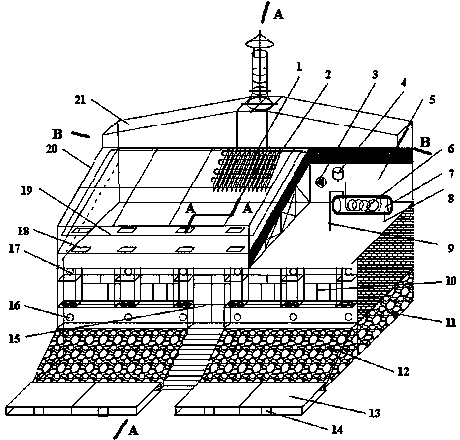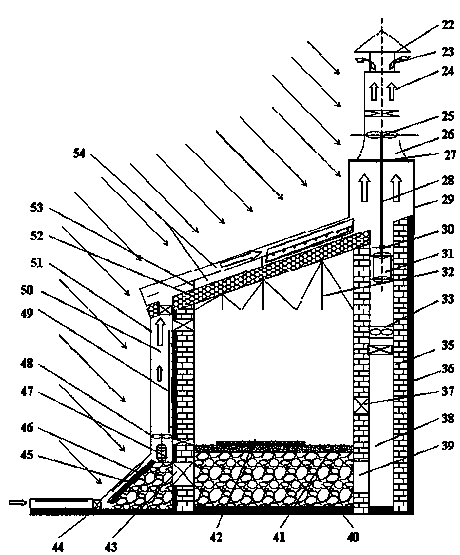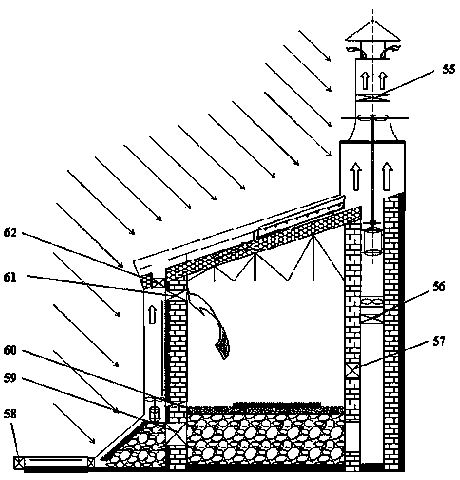Solar energy and building integrated hot air power generation, ventilation and heating system
A technology of heating system and solar energy, which is applied in the field of combined hot air power generation and building heat storage heating, which can solve the problems of power consumption, large energy consumption, and waste of heat energy, so as to improve the guarantee rate and reliability, and improve the utilization Efficiency, efficient and rational use of the effect
- Summary
- Abstract
- Description
- Claims
- Application Information
AI Technical Summary
Problems solved by technology
Method used
Image
Examples
Embodiment 2
[0038] Embodiment 2: on the basis of embodiment 1, will be in Figure 5 The X-type interlayer air inlet duct 38 in the middle is made into a single-passage cross-sectional shape that is a rectangular or circular pipe shape, such as Figure 6 As shown, at this time, a confluence groove 66 is designed below the air inlet 65, a ventilation hole 67 is designed below the air inlet duct, and a valve 68 is designed at the ventilation hole 67. There can be one ventilation hole 67 and the valve 68, or one There are 2 to 3. What needs to be explained is that the sandwich-type air inlet duct has small wind resistance and large heating area, but the construction cost is high, while the single-channel duct-shaped air duct with a rectangular or circular cross-section shape is low in construction cost, but the convection heating efficiency is relatively low. poor.
Embodiment 3
[0039] Embodiment 3: on the basis of embodiment 1, will be in Figure 5 The X-type interlayer air intake duct 38 in the middle is made into a multi-channel cross-sectional shape that is rectangular or circular, such as Figure 7 As shown, at this time, a confluence groove 66 is designed below the air inlet 65, and a flow divider 69 is designed below the fan. The flow divider 69 is connected with 2 to 6 lower air intake ducts 70, and each air intake duct 70 is below Ventilation holes 71 are all designed, and valves 72 are designed at each ventilation hole 71, and there can be 1 or 2 to 3 ventilation holes 71 and valves 72 on each lower air inlet duct 70. It should be noted that: the construction cost of single-channel ducts with rectangular or circular cross-sections is low, but the convection heating efficiency is relatively poor, while the construction of multi-channel ducts with rectangular or circular cross-sections The cost is high, but the convection heating efficiency i...
Embodiment 4
[0040] Embodiment 4: on the basis of embodiment 1, will be in figure 1 The heat exchanger 6 in the water tank 7 is removed, and the water pump 3 directly pumps the water in the water tank into the U-shaped pipe 1, which can improve thermal efficiency. At this time, the expansion tank 4 can also be omitted in the pipeline to form a solar direct heating system. . It should be noted that although this direct heating system is simple and efficient, it has the problem of water scaling in the U-shaped pipe and the problem of preventing the water in the pipe from freezing in winter.
PUM
 Login to View More
Login to View More Abstract
Description
Claims
Application Information
 Login to View More
Login to View More - R&D
- Intellectual Property
- Life Sciences
- Materials
- Tech Scout
- Unparalleled Data Quality
- Higher Quality Content
- 60% Fewer Hallucinations
Browse by: Latest US Patents, China's latest patents, Technical Efficacy Thesaurus, Application Domain, Technology Topic, Popular Technical Reports.
© 2025 PatSnap. All rights reserved.Legal|Privacy policy|Modern Slavery Act Transparency Statement|Sitemap|About US| Contact US: help@patsnap.com



